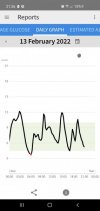What happened at 3am Ian? Did you have any insulin late in the evening? Or correct overnight?
Looks like you had breakfast at 8.30ish, lunch at 1ish and evening meal around 5.30?
One thing to bear in mind is that the rises and falls always look a bit sharper when you condense big sections of the day (12 or 24 hours) onto a smallish screen.
Your overall levels look really good, but I think what you are referring to are two things. Glucose instability, and glucose variation. Glucose variation is the numbers at the outer edges - how high you got, and how low you got. And glucose instability is how quickly and frequently you bounced between those two extremes.
These are two different things you can work on, and some of the techniques overlap. These are the things I spend time looking at when my graph gets a bit ’mountain rangey’:
- Basal - is it keeping my BG as level as possible through the 24 hours. Fasting basal checks really helped me understand this. If my basal is a little bit out it can have a massive impact on how my meal doses / corrections work.
- Carb counting - trying to make my meal estimates as accurate as possible. Higher carb loads tend to be riskier for me. and bigger doses seem more subject to erratic absorption.
- Carb selection - trying to choose sources of carbs that absorb fairly gently and roughly in line with insulin action. And predicting those that absorb particularly slowly where the dose may need to be split over a longer time frame.
- Prebolus timing - if I get a big ‘spike’ soon after eating but I am back where I started 5 hours later, then the dose was right, but the insulin was late getting started. SomI cautiously experiment with leaving 5 minutes extra between dosing and beginning to eat. Sometimes I have needed 30-40 minutes wait for the insulin to be ready for the food!
- Exercise/activity with insulin on board - a relatively recent one this, but I now get some proper divebombs of BG when just gently walking if I have insulin active. It can help me to take a small amount of fast carbs as a precaution when BG still mid-range to prevent a steep drop in 10 minutes’ time.
Good luck, and let us know how you get on
🙂

